A Technical Roadmap Template That Actually Works
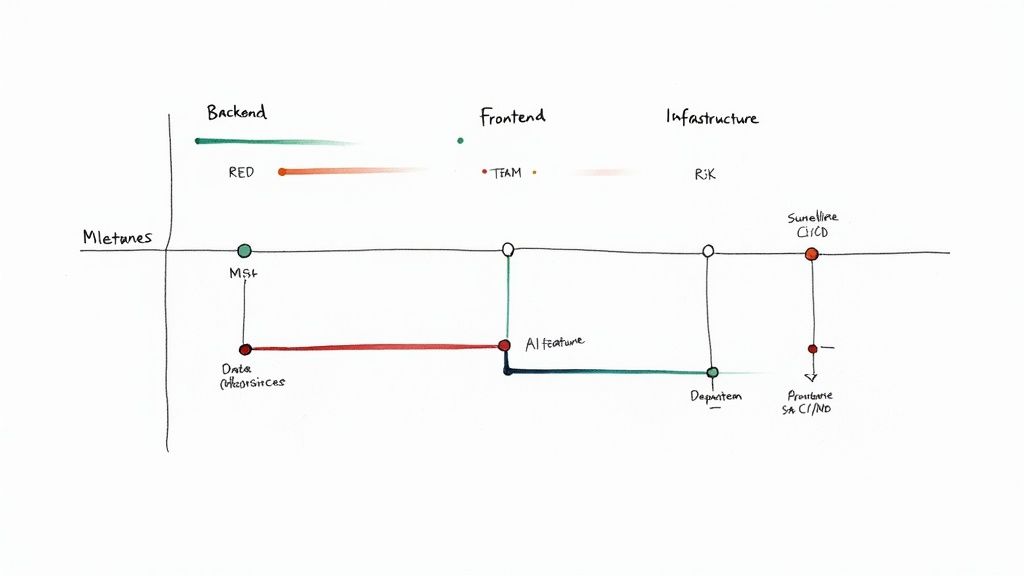
Staring at a blank document trying to create a technical roadmap from scratch is a special kind of painful. It feels like you are supposed to conjure a perfect, visionary strategy out of thin air. The good news? You do not have to.
I once worked on a project that nearly went off the rails because our "roadmap" was nothing more than a feature list passed down from the product team. Everyone was scrambling, priorities shifted daily, and a quiet sense of chaos settled in. The actual plan was hidden in plain sight, scattered across Jira, Slack, and the brains of our senior engineers. It was buried in the tech debt tickets we kept putting off, the infrastructure upgrades we all knew were coming, and the unspoken dependencies between teams that only blew up during a crisis.
This realization changes everything. What if the roadmap is not something you invent? What if it is something you uncover? The job is not to build a plan from nothing; it is to document reality. The pieces are already there. You just need to be an archaeologist, dig up the artifacts, and assemble them into a story that makes sense.
Your Roadmap Already Exists You Just Need to Find It
It is tempting to want a clean, new plan. But the roadmaps that actually work are honest reflections of where you are right now and what desperately needs to get done, not just a pretty wishlist. The clues are everywhere if you know where to look.
The Art of Uncovering Your Hidden Plan
Before we go deeper, let us pause and reflect. The goal here is not perfection. It is clarity. We are trading the anxiety of a blank page for the detective work of finding clues.
- Jira Tickets and Tech Debt: Your backlog is an absolute goldmine. Sift through it for recurring bugs, performance complaints, or those tickets that get pushed from sprint to sprint. These are not just chores; they are signposts pointing directly at the systemic weaknesses your roadmap needs to fix.
- Engineer Slack Channels: Listen to the chatter. What are engineers really complaining about? Is the CI/CD pipeline painfully slow? Is the local dev environment a total nightmare to set up? I once saw a thread about a flaky test suite that went on for days. That frustration is not just noise; it is a clear signal that developer experience is a bottleneck. These day to day frustrations are often the highest impact items you can tackle to boost team velocity and morale.
- Product Team Aspirations: While a feature list is not a roadmap, it is packed with crucial intel. When a product manager says, "We want to launch in Europe next year," your engineering brain should immediately translate that to: "We need to plan for data localization, i18n frameworks, and multi region infrastructure."
The technical roadmap is not just one thing; it is a collection of critical components that, when brought together, create a clear and actionable plan. Each piece serves a specific purpose, from defining the 'what' and 'when' to anticipating the 'what ifs.'
Core Components of a Functional Technical Roadmap
Here is a quick breakdown of the essential elements every solid technical roadmap should include. Think of this as your reference guide for making sure you have covered all your bases.
| Component | What It Is | Why It Matters |
|---|---|---|
| Timeline | A visual representation of when initiatives are planned to start and end, often broken down by quarters or sprints. | It sets expectations with stakeholders and provides a high level view of sequencing and resource allocation. |
| Milestones | Specific, measurable checkpoints within larger initiatives that signify meaningful progress (e.g., "Alpha release," "Infra migration complete"). | Milestones make large projects feel manageable and provide clear success markers for the team and leadership. |
| Dependencies | The relationships between tasks, showing which initiatives must be completed before others can begin. | This is critical for realistic planning. Ignoring dependencies is the fastest way to derail a project. |
| Risks | Potential problems or uncertainties that could impact the timeline, budget, or success of an initiative. | Identifying risks upfront allows you to create mitigation plans instead of just reacting when things go wrong. |
| KPIs/Metrics | Key Performance Indicators used to measure the success of an initiative (e.g., "Reduce API latency by 30%," "Improve CI/CD build time"). | Metrics ensure you are solving a real problem and can prove the value of the technical work being done. |
| Owners | The individual or team responsible for delivering each initiative. | Clear ownership prevents things from falling through the cracks and ensures someone is accountable for progress. |
Having a structure to place these components into is what turns a collection of ideas into a coherent strategy. Without it, you are just juggling a long list of disconnected tasks.
Why a Template Is Your Assembly Guide
Finding all these scattered pieces is one part of the job; putting them together is another challenge entirely. This is where a technical roadmap template becomes your best friend. It provides the framework you need to organize the chaos you have just uncovered.
And this is not just a gut feeling; the data shows that structured planning works. The adoption of standardized roadmap templates has surged for a reason. A 2023 World Bank report found that over 70% of large enterprises now use some form of technology roadmap template. More importantly, those companies are 40% more likely to hit their digital transformation goals on time.
A great roadmap does not invent a perfect future. It makes the messy, complicated present understandable and actionable. It turns scattered problems into a focused strategy for moving forward.
By using a template, you are creating specific buckets for all that disparate information you have gathered. That engineer's complaint about the "slow pipeline" now has a home under "Developer Experience Initiatives." The product team's dream of European expansion gets a dedicated section for "Scalability and Globalization." It is a simple shift, but it transforms the work from reactive firefighting to proactive, strategic execution.
Building Your Template with the Key Ingredients
Okay, let us get practical. It is one thing to talk about uncovering all the bits and pieces of your roadmap; it is another to actually assemble them into something that holds up under pressure. A solid technical roadmap template is your workbench for this process, giving every component a dedicated home.
We are not just going to list sections here. I want to dig into the why behind each one, using examples from projects I have been on. This will show you how they all connect to prevent the usual chaos down the line. The goal is a living document, not some static artifact that gets buried in a forgotten Confluence page.
This whole process really boils down to three phases: discovery, assembly, and strategy.
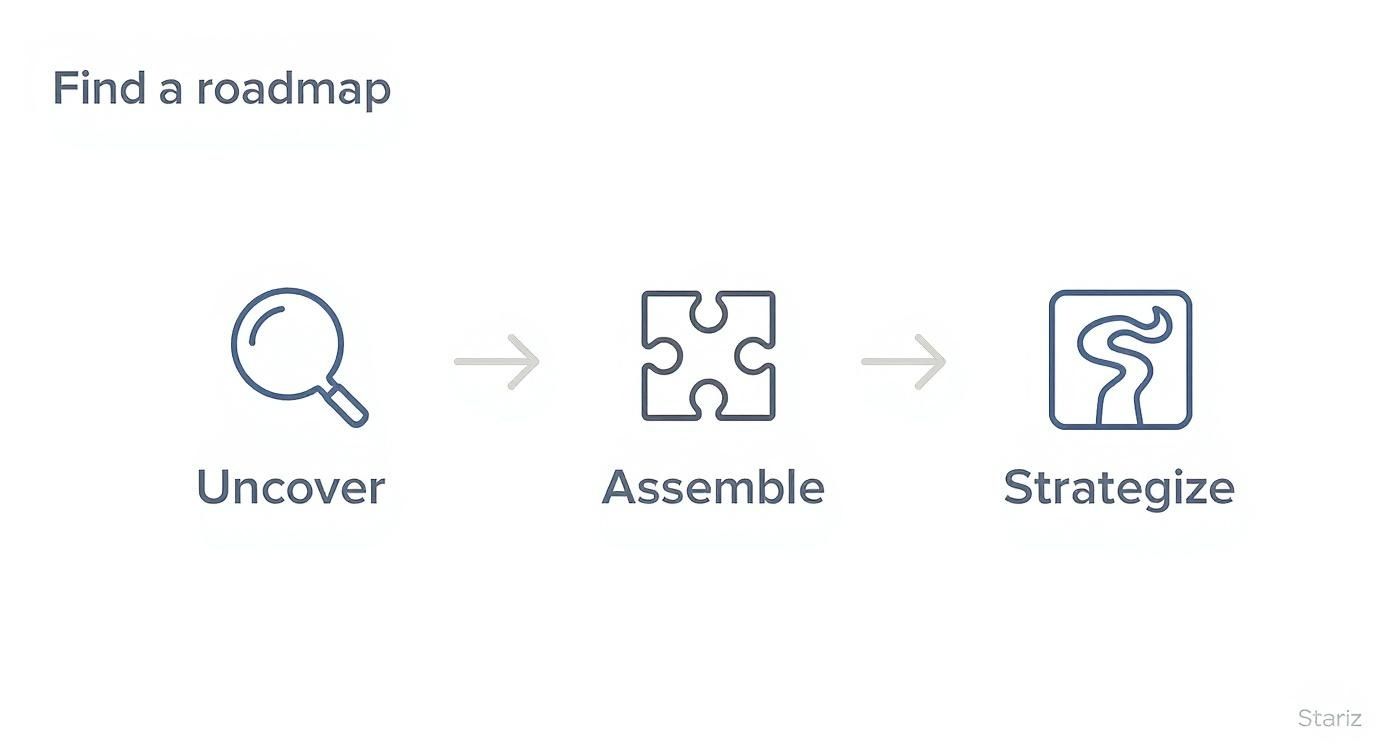
You have to uncover the needs first, then assemble the pieces into a structured template, and finally, strategize how you will actually execute the plan.
Structuring Your Template with Swimlanes
First up: structure. Over the years, I have found that a swimlane format is incredibly powerful. Each lane represents a different team or technical domain, think backend, frontend, infrastructure, or even data science.
This visual separation is a game changer. It instantly clarifies who owns what and makes cross team dependencies almost painfully obvious. When you see a line connecting an item in the "backend" lane to one in the "frontend" lane, you cannot just ignore the coordination that is needed.
The point of a good template is not just to list tasks. It is to visualize the entire system of work. When you can see the connections and bottlenecks, you can manage them before they become emergencies.
For instance, a project to launch a new GenAI feature might break down like this:
- Backend Lane: Build the new RAG pipeline API.
- Data Science Lane: Fine tune the embedding model for our specific domain.
- Frontend Lane: Create the user interface for the AI chat.
Suddenly, the sequence is crystal clear: the frontend cannot finish their work until that backend API is live.
Defining Realistic Timelines and Milestones
Timelines are where roadmaps often drift into pure fantasy. We have all been there, staring at a Q3 deadline for a project that feels more like a Q1 next year kind of problem. To ground your template in reality, focus on milestones instead of rigid end dates.
A milestone is a tangible outcome, not just a point in time. It should answer the question, "What will be different once this is done?"
- Bad Milestone: "Finish Auth Service." (Too vague, what does "finish" even mean?)
- Good Milestone: "Users can successfully log in via the new JWT authentication service in our staging environment."
Breaking huge initiatives into smaller, outcome based milestones makes progress visible and creates natural checkpoints to adjust the plan. It also has the side effect of making your estimates way more accurate. If you need a deeper dive on this, we have got a whole guide on creating a realistic software project estimate.
Mapping Dependencies to Prevent Bottlenecks
Dependencies are the silent killers of product timelines. I once worked on a team where a critical infrastructure upgrade was planned for the exact same sprint as a major feature launch that relied on it. The result was predictable chaos. Your template must make these connections impossible to miss.
In your template, add a dedicated "Dependencies" column for every single initiative. And be brutally specific.
| Initiative | Owner | Dependencies |
|---|---|---|
| Build New Reporting UI | Frontend Team | API-241: Reporting Endpoint from Backend Team must be deployed to staging. |
| Deploy Reporting Endpoint | Backend Team | INFRA-78: New database index must be applied by the Infrastructure Team. |
This simple table forces conversations that would otherwise happen way too late. It is your built in early warning system for future gridlock.
Assessing Risk and Implementing Status Tracking
Finally, no plan survives contact with reality. Your template needs a way to track risk and status without sending everyone into a panic. A simple but highly effective method is the RAG (Red/Amber/Green) status system.
- Green: On track. No major blockers identified.
- Amber: Some risks are looming or minor delays have occurred. This needs attention.
- Red: Blocked or significantly behind schedule. This requires immediate intervention.
Pair this with a "Risk" column where you briefly describe potential issues. This is not about listing every possible doomsday scenario; it is about calling out the top 1–2 realistic threats to an initiative.
To get this information from your team right from the start, you can use product roadmap survey templates to gather their initial thoughts. This keeps communication clear and focused on solutions, not just problems.
Adapting Your Roadmap for Real World Scenarios
A generic template is a fantastic starting point, but let us be honest, it is just a skeleton. The real magic happens when you flesh it out to fit the unique pressures of an actual project. I have seen too many roadmaps become irrelevant because teams stuck too rigidly to a one size fits all format.
The moment you face a high stakes scenario, certain parts of that template suddenly become way more important than others. I have seen teams obsess over detailed KPIs for an MVP where the only metric that truly mattered was "did we ship it?" Conversely, I have seen infrastructure projects flounder because they were treated like feature launches, with no deep thought given to dependencies and risks.
This is where the technical roadmap template proves its worth, shifting from a simple planning document into a powerful communication tool. It forces you to prioritize what matters right now.
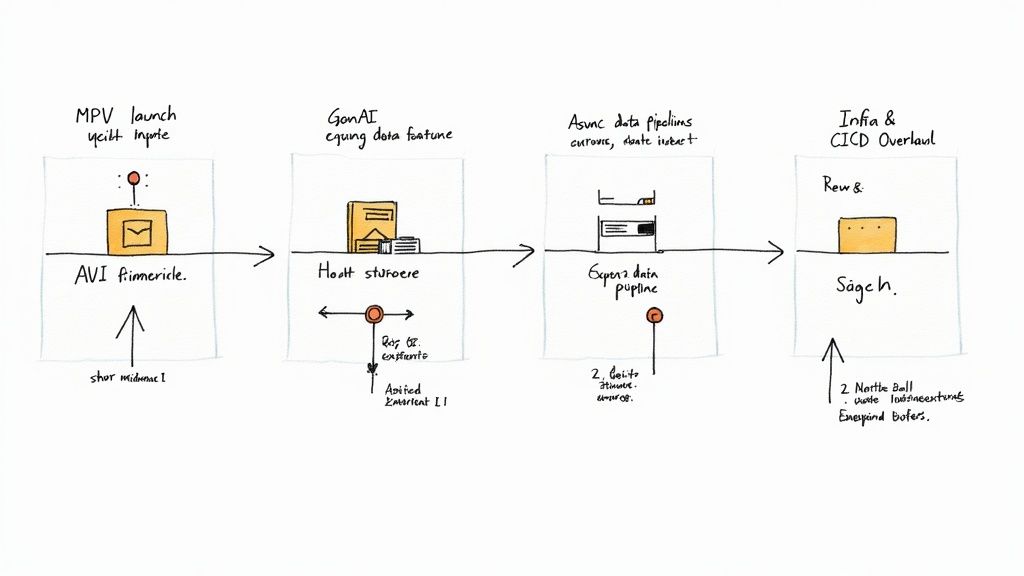
Let us walk through four common but tricky scenarios. For each one, we will look at how to adapt the template, focusing on the sections that need the most attention to get buy in from both your CTO and your product manager.
Scenario 1: The MVP Launch
When you are pushing out a Minimum Viable Product, speed is everything. The whole point is to get something, anything, into users' hands to see if your core idea has legs. Your roadmap needs to reflect this ruthless focus.
- Timeline: Keep it short and aggressive. Think 6 to 8 weeks, tops. You should be breaking this down by the week, not by the quarter.
- Milestones: Frame them as user visible outcomes. "Users can create an account" is a great milestone. "Backend auth service v1 complete" is engineering jargon and does not belong here.
- Risks: The biggest risk is almost always scope creep. Your roadmap needs to call this out explicitly, so everyone knows the danger.
- KPIs: Forget complex metrics for now. The main KPI is the launch itself. Secondary metrics might be "time to first user signup" or "core workflow completion rate."
For an MVP, the roadmap's job is to carve the straightest possible line to launch day. Every initiative that deviates from that line should be questioned mercilessly. It is about building a skateboard, not a car.
Scenario 2: Integrating a GenAI Feature
Dropping a Generative AI feature, like a RAG system, into an existing product is a completely different ballgame. The roadmap here is less about a linear path and more about structured experimentation.
Your focus shifts dramatically toward the data pipeline and model performance. A 2025 Technology Adoption Review from the UK government actually found that 85% of leading firms use detailed roadmaps to guide tech investments, especially for AI where a structured plan can speed up deployment by 50%. You can read the full technology adoption review for the details.
- Initiatives: Do not be afraid to frame these as experiments. "Test Llama 3 vs. Mistral for response quality" is a perfectly valid and crucial roadmap item.
- Dependencies: These are critical. You have to map out the entire data flow: ingestion, chunking, embedding, and retrieval. A bottleneck anywhere in that chain can stall the entire project.
- KPIs: Here, quality and performance are everything. Metrics like "retrieval accuracy," "response relevance," and "end to end latency" are your north stars.
- Risks: The big ones are technical uncertainty and data quality. "Model performance does not meet user expectations" is a very real risk that needs to be on the board.
Scenario 3: Building Async Data Pipelines
When your job is to build a new asynchronous data pipeline with tools like Celery and RabbitMQ, the user facing impact is often indirect. This makes communicating the value tricky, so your roadmap has to visualize the invisible work.
The emphasis here is squarely on architecture, reliability, and observability. The swimlanes showing how different services interact become the most important part of the document.
- Timeline: Plan for phased rollouts. Start by processing a small percentage of jobs through the new system, then gradually ramp it up.
- Milestones: Center them around reliability and observability. "Pipeline successfully processes 1 million tasks with <0.1% error rate" is a powerful milestone. "Metrics dashboard for queue depth and task latency is live" is another winner.
- Dependencies: Map out every single service interaction. What happens if the Redis server goes down? What is the retry logic? These details have to be explicit.
- Owners: Clear ownership for each microservice or component in the pipeline is absolutely non negotiable.
Scenario 4: An Infrastructure and CI/CD Overhaul
This is often the hardest roadmap to sell. To a non technical stakeholder, it can look like you are doing a ton of work for zero new features. Your roadmap's main job is to translate deep technical work into direct business value. A solid plan here also prevents future headaches, the kind of stuff that gets uncovered during a painful technical due diligence audit.
You need to frame every single initiative around developer velocity, system stability, or future scalability.
- Initiatives: Kill the technical jargon. Instead of "Migrate to Kubernetes," try "Enable faster, safer deployments and auto scaling." See the difference?
- KPIs: Metrics are your best friend. "Reduce average CI build time from 20 minutes to 5 minutes" is gold. So is "Increase deployment frequency from weekly to daily." These are numbers leadership understands.
- Risks: The biggest risk is disruption. Acknowledge it head on with a mitigation plan, like "Staged rollout to internal services first, with a clear rollback strategy."
- Dependencies: Your entire engineering organization is a dependency. You have to communicate clearly and often about planned downtime or changes to their workflow.
How to Present Your Roadmap and Get Buy In
I learned a tough lesson a few years back: a technically perfect roadmap can still fall completely flat. I had poured weeks into it, mapping dependencies, assessing risks, projecting timelines. It was a thing of beauty. But when I presented it, all I got were blank stares. It landed with a thud.
What I missed is that creating the roadmap is only half the battle. The real work starts when you have to turn that plan into a shared vision. A roadmap is a document, but a presentation is a story. And to get real buy in, you have to tell the right story to the right people.
It is all about translating the technical how into the business why.
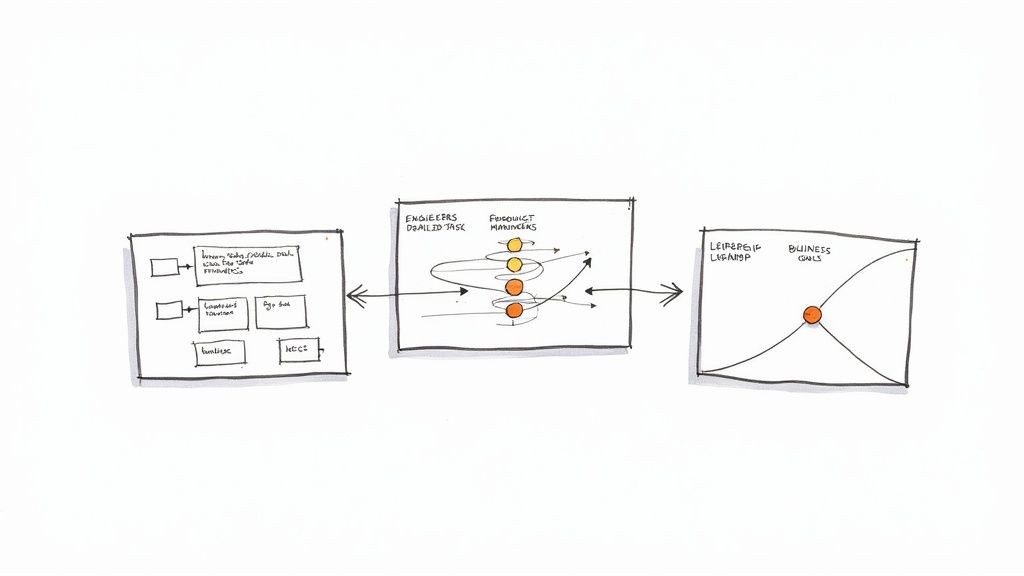
This means you cannot just walk into three different meetings with the same slide deck. Your engineers, your PMs, and your execs all speak different languages. Your job is to connect the roadmap to what each of them cares about most.
Talking to Engineers: Clarity and Challenges
When you are in a room with your engineering team, the goal is to build confidence and alignment. This is your home turf. You can, and should, go deep into the technical weeds. They do not just want to be told what to build; they want to understand the architectural choices and the thorny problems they will be solving.
Your talking points need to hit on:
- The Technical 'Why': Do not just say you are moving to Kubernetes; explain why it is better than the current setup. What specific performance bottlenecks will this new data pipeline actually solve? They will respect the reasoning.
- The Hard Problems: Be brutally honest about the toughest parts of the plan. Point out that complex migration or that tricky third party integration. It shows you have thought through the messy details and you respect their expertise enough to be upfront.
- Dependencies and Connections: Use the roadmap to clearly show how one team's work will impact another. Visualizing these links helps kill surprises down the line and makes everyone feel like they are part of a cohesive plan.
For engineers, the roadmap is not just a list of tasks, it is the blueprint for the future they are building. Your job is to give them the clarity and confidence to build it well, even when it is ambitious.
Aligning with Product Managers: Features and Timelines
Product Managers operate in a world of user stories, feature launches, and market pressures. For them, the technical roadmap needs to answer one question: how does this help us ship a better product, faster? They need to see a straight line from that infrastructure project to their product goals.
Frame your conversation around these points:
- Connect Tech Work to Product Goals: Never, ever present a technical project in isolation. It is not "Upgrade the database." It is "Enable the new real time analytics feature by improving query performance." See the difference?
- Talk About Trade Offs Openly: Your roadmap makes choices explicit. If a tech debt sprint is going to push a feature back by two weeks, explain the long term win. A more stable platform means fewer bugs and faster development later. This turns a potentially tense conversation into a strategic one.
- Get Real About Timelines: PMs need realistic dates to do their jobs. Be clear about what is a hard deadline and what is a soft estimate. This builds trust and stops the dreaded "is it done yet?" dance.
If your tech stack feels like it is holding you back, these conversations can be especially tricky. It is the perfect moment to align on the foundational work needed for real growth. We have written more about navigating this in our guide on what to do when your tech stack feels like it's held together with duct tape.
Selling to Leadership: Business Goals and ROI
When you are presenting to your CTO, CEO, or the board, the technical details fade into the background. They have one fundamental question: how does this help the business win? They are thinking about revenue, market share, and operational efficiency. Your presentation must speak their language.
Build your story around business outcomes:
- Lead with the Impact: Start with the "so what?" Do not kick off with the details of a CI/CD overhaul. Instead, lead with, "We are going to increase our deployment frequency by 4x, which will let us ship features faster than our competition."
- Quantify Everything You Can: Pull the KPIs straight from your roadmap. "This initiative will reduce our monthly cloud costs by an estimated 15%" is infinitely more powerful than "We are going to optimize our infrastructure."
- Frame it as Risk Mitigation: Tech debt is not just an engineering problem; it is a business risk. Explain how the roadmap tackles threats to stability, security, and the company's ability to innovate in the future.
By tailoring your message this way, your technical roadmap transforms from a dry project plan into a compelling vision for the future, a vision that everyone, from a junior engineer to the CEO, can understand and get excited about.
Do Not Let Your Roadmap Become a Museum Piece
A roadmap is not a "fire and forget" document. I have seen it happen too many times: a team spends weeks crafting a brilliant, thoughtful roadmap, presents it with a ton of excitement, and then... it withers away in a shared drive. Within a quarter, it is a relic, a snapshot of a plan that reality left behind long ago.
Why does this happen? The number one killer is rigidity. We operate in a world where new user feedback or a competitor's move can shift our priorities overnight. A plan set in stone is a plan doomed to fail. Think of it as a guide, not a contract written in blood.
The Danger of Shadow Work
One of the hardest lessons I learned about roadmap decay came from a silent productivity killer: shadow work.
This is all the unplanned, unroadmapped stuff that inevitably eats up your team's time. It is the urgent bug fix for a key customer, the "quick" data pull for the marketing team, or that side project an engineer spins up to fix an annoying deployment script.
Individually, these tasks feel small and justifiable. But they add up. Fast. Before you know it, a huge chunk of your team's capacity is being burned on work that is completely invisible on the official plan. This is what causes your planned work to slip, which erodes trust in the roadmap itself. A roadmap is only useful if it is an honest reflection of where the team is actually spending its time.
A roadmap that does not account for reality is not a strategy; it is a fantasy. The moment it deviates too far from what the team is actually doing, it loses all credibility and becomes useless.
Building in Flexibility with Regular Check Ins
So, how do you keep the roadmap from becoming a work of fiction? You treat it like a living document, with regular, predictable review cycles. This is not about adding bureaucracy; it is about creating a forum for honest recalibration.
While a big picture strategic review might happen quarterly, you need lighter weight check ins much more often, maybe monthly, or every couple of sprints. The goal is not to assign blame for deviations. It is to adapt to new information.
Here is a simple checklist for making these reviews count:
- Check the Vitals: How are we tracking against our milestones? Use your RAG status (Red/Amber/Green) to quickly pinpoint what is on fire and what is cruising.
- Question Everything: Are the problems we set out to solve still the most important ones? Did a competitor just launch something that changes the game?
- Surface New Intel: What have we learned? Did that technical spike reveal an initiative is way harder than we thought? Did user interviews uncover a more pressing need?
- Adjust and Re Prioritize: Based on all that, what needs to change? Does an item get pushed? Does something new and urgent jump the queue?
This rhythm ensures your technical roadmap template actually adapts. It also forces you to get a better handle on tracking team effort and where the time is really going. To get more tactical on that, check out our guide to engineering productivity measurement, which is full of metrics that can ground these review conversations in data.
Looking ahead, this process is becoming even more dynamic. A 2025 Future Today Strategy Group Tech Trends Report found that 60% of organizations are now using AI enhanced roadmap tools that pull in real time data. These systems have improved technology forecasting accuracy by up to 35%, helping teams see around corners before they get there. You can dig into these AI-driven templates in the full report.
We have covered a lot of ground, from digging into the hidden technical plan inside your organization to adapting the roadmap template for some high stakes scenarios. Even so, a few common questions always seem to pop up. Let us tackle them head on.
How Is a Technical Roadmap Different From a Product Roadmap?
This is probably the most common point of confusion I hear, and it is a great question. The simplest way I think about it is separating the "what" from the "how."
A product roadmap is all about the what and the why, told from the user's perspective. It is focused on customer value and business outcomes.
- Example: "Users can create and share custom PDF reports from their dashboard."
A technical roadmap details the how for the engineering team. It is our tool for making the invisible, but absolutely essential, work visible and plannable.
- Example: "Build a new reporting API endpoint" and "Upgrade our PDF generation library to version 3.0."
The technical roadmap gives a name and a place to critical work like infrastructure upgrades, security hardening, and paying down tech debt. These are the tasks that are fundamental to product success but do not really show up on a feature list.
How Detailed Should My Technical Roadmap Template Be?
It is a balancing act, for sure. If your roadmap gets too granular, it just becomes another project management tool that is impossible to keep updated. But if it is too high level, it loses its power for spotting dependencies or planning resources.
The sweet spot is what I call the 'initiative' or 'epic' level. A single roadmap item should represent a significant chunk of work, something that will likely take a team several weeks to a full quarter.
For instance, "Implement new authentication service" is a perfect roadmap item. It is substantial, has clear goals, and can be easily broken down into smaller tasks during your normal sprint planning. Something like "Fix login button CSS," on the other hand, definitely does not belong on the roadmap.
Who Is Responsible for the Technical Roadmap?
While the CTO or VP of Engineering usually has the ultimate accountability, the best roadmaps I have seen are always a collaborative effort. It absolutely should be led by senior engineers and tech leads, the people who are closest to the code and understand the underlying challenges.
Product managers are crucial partners here, bringing in the business priorities and customer needs. But the engineering team has to own the technical details, the effort estimates, and the dependency mapping. This shared ownership is what keeps the roadmap both strategically aligned with company goals and grounded in technical reality.
How Often Should We Update the Technical Roadmap?
A roadmap is a living document, not some static artifact you create and forget. If you only look at it once a year, it is already useless.
Plan for a major review and update on a quarterly basis. This timing usually syncs up nicely with broader business planning cycles like OKRs. That said, it should also be adjusted more frequently, maybe a lightweight review every few sprints, to reflect new information, unexpected hurdles, or shifting priorities. The main goal is to keep it accurate and trusted by the team.
Ready to stop wrestling with scattered plans and build a roadmap that actually drives your team forward? Kuldeep Pisda specializes in helping startups translate complex technical needs into clear, actionable strategies. If you need help crafting a production grade roadmap or strengthening your engineering foundations, let's connect and build something great together.
Subscribe to our newsletter.
Become a subscriber receive the latest updates in your inbox.


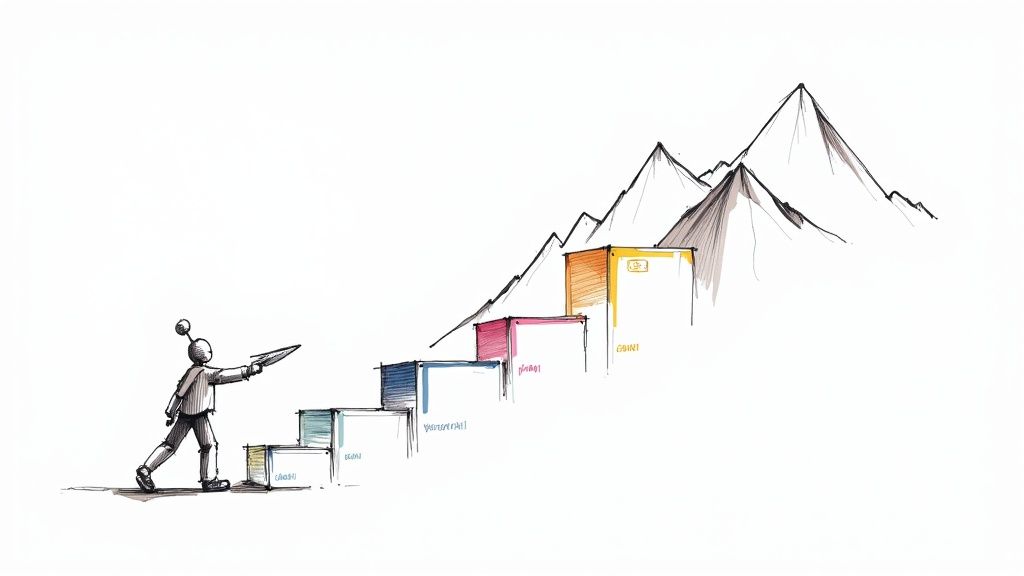
Member discussion